Uncover the pivotal role of tent makers in the Bible, weaving together faith, work, and the fabric of biblical society.
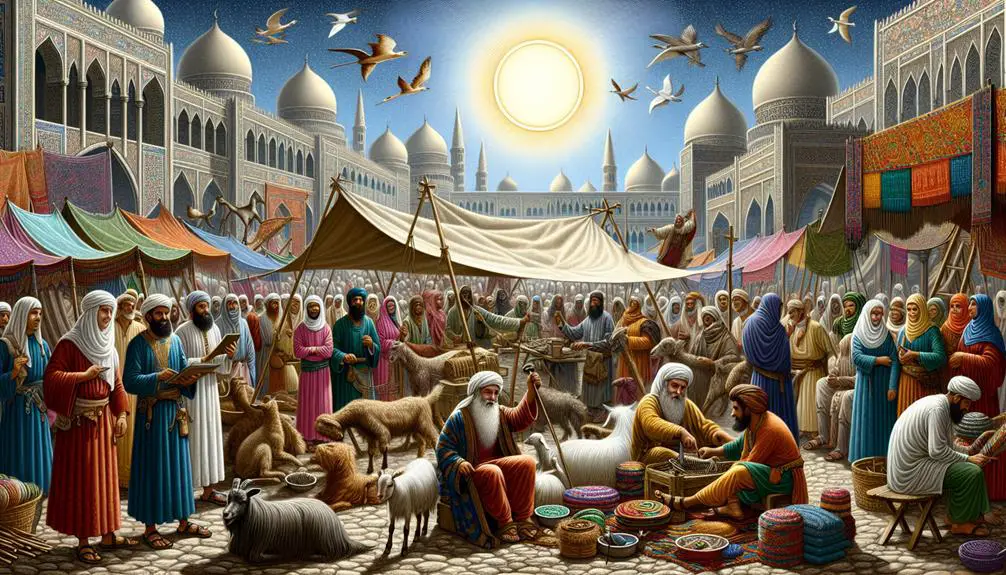
Tent Makers in the Bible
Have you ever considered the humble tent maker's role in the grand narrative of the Bible?
You're likely familiar with the Apostle Paul, who balanced his missionary work with crafting tents, but there's more beneath the surface of this trade. This profession wasn't just about providing shelter; it held significant spiritual and societal implications in biblical times.
As we explore the craft of tent making, Paul's dual role, and the deeper meanings behind biblical references to tents, you'll discover how these artisans shaped both the physical and metaphorical landscape of their world.
Stay with us as we uncover the threads that weave together faith, work, and everyday life in biblical times.
Key Takeaways
- Apostle Paul utilized his tent-making skills to support his missionary work and integrate secular employment with his spiritual vocation.
- Tents, made from durable materials like goat hair, symbolize God's protection and the believer's transient journey towards a permanent home.
- The craft of tent making, passed through generations, was crucial for nomadic lifestyles, economic contributions, and fostering community interdependence.
- Biblical references to tents serve as powerful metaphors for faith, community, and the human condition, reflecting the divine-earthly connection.
The Craft of Tent Making
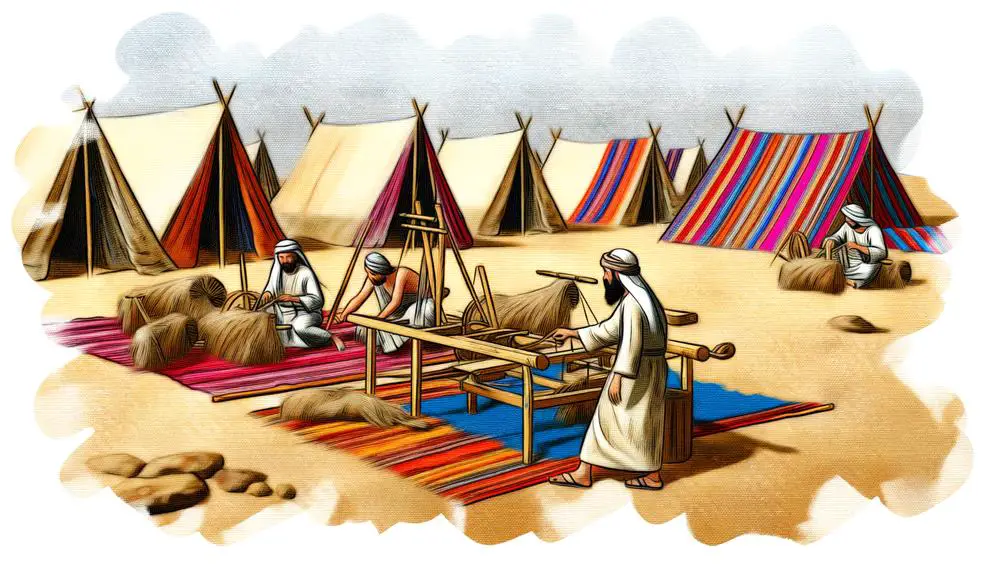
Tent making in biblical times involved skilled craftsmanship, utilizing materials such as goat hair and linen to construct shelters designed for mobility and durability. You'd find these artisans selecting their material choices with great care, understanding that the quality of the fabric directly influenced the tent's ability to withstand harsh desert climates. Goat hair, in particular, was prized for its water-resistant and durable qualities, making it an ideal choice for creating tents that could endure the elements while providing a semblance of comfort.
The historical techniques employed by these craftsmen were refined through generations. They'd weave the materials into large pieces of fabric, which were then sewn together with strong, resilient stitches. This process wasn't merely about assembling a structure; it was an art form, requiring precision and a deep understanding of the materials at hand. The artisans needed to ensure that the tents weren't only sturdy but also portable, as their primary users were nomadic people who moved frequently in search of grazing lands for their livestock.
Moreover, the design of these tents reflected a keen awareness of the environmental challenges faced by their inhabitants. The color and texture of the goat hair fabric, for instance, provided natural insulation against the heat during the day and the cold at night. This attention to detail in the material choices and construction techniques underscores the sophistication of tent making in biblical times. It wasn't just about creating shelter; it was about crafting a mobile home that could withstand the test of time and travel, embodying the transient yet resilient spirit of its people.
Apostle Paul's Dual Role
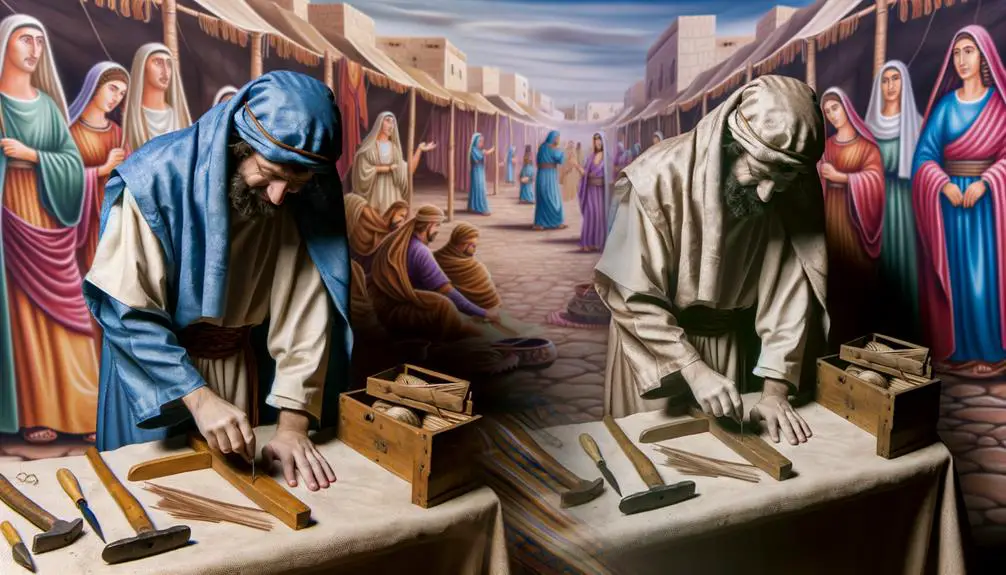
Reflecting on the craft of tent making, it's notable that Apostle Paul himself was adept in this trade, embodying a dual role that intertwined his craftsmanship with his spiritual mission. Paul's occupation not only served as a means of livelihood but also facilitated his missionary journeys, allowing him to be self-sufficient and less of a financial burden on the communities he ministered to. This aspect of his life highlights a pragmatic approach to spreading the gospel, where vocational skills and spiritual calling seamlessly merge.
Throughout his missionary journeys, Paul's tent-making skills were more than just a source of income; they represented a strategic tool for evangelism and church planting. Engaging in this trade provided Paul with unique opportunities to interact with a diverse range of people, from fellow craftsmen to customers, thereby broadening the scope of his missionary outreach. This vocational engagement allowed him to establish a common ground with those outside the faith community, making his message more relatable and accessible.
Moreover, Paul's dual role as a tent maker and apostle underscores the integration of secular work and divine vocation, challenging the dichotomy often perceived between the sacred and the secular. It suggests that work, regardless of its nature, can be a form of ministry and a platform for witnessing. In this light, Paul's life serves as a compelling example of how believers can leverage their professional skills for the advancement of the gospel, emphasizing that every occupation has the potential to contribute to the kingdom's work.
Biblical References to Tents
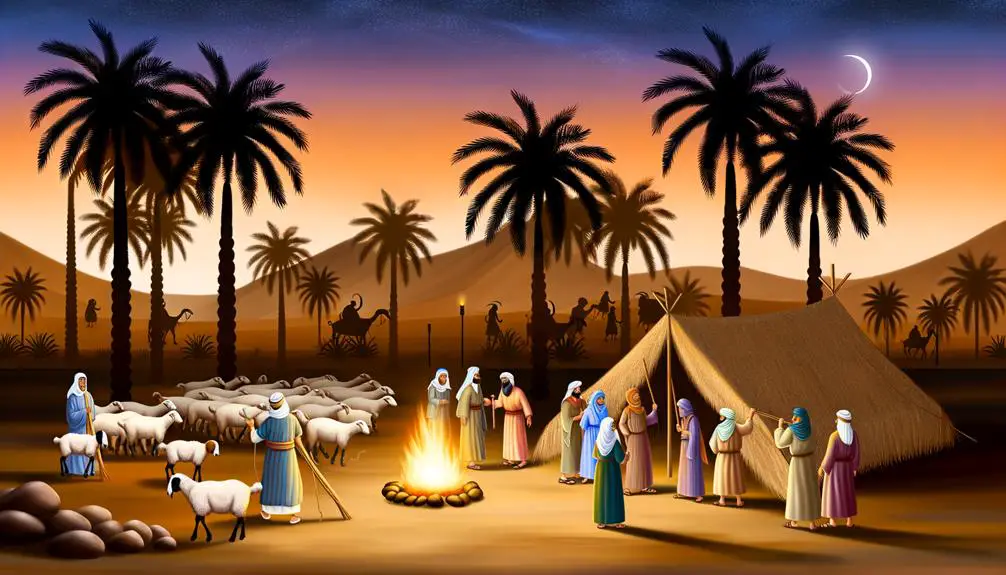
Throughout the Bible, various references to tents serve as powerful metaphors and literal shelters, highlighting their significance in both historical and spiritual contexts. You'll find that the nomadic lifestyle of many Biblical characters necessitated the use of tents, not just as temporary dwellings but as integral parts of their daily lives. This reliance on tents isn't merely a matter of circumstance but deeply woven into the fabric of their existence, both physically with the use of fabric materials and symbolically.
The materials used for these shelters were often derived from their immediate surroundings, including animal skins and woven textiles, showcasing the resourcefulness and adaptability of these nomadic communities. These fabric materials weren't chosen randomly; they were selected for their durability, flexibility, and ability to provide protection from the elements, crucial qualities for a life constantly on the move.
Moreover, tents in the Bible aren't just physical structures; they're imbued with rich symbolic meaning. They represent God's presence and protection, as seen in the Tent of Meeting where Moses would converse with God. This connection between the divine and the everyday elevates the tent from a simple shelter to a sacred space, blurring the lines between the heavenly and the earthly.
In analyzing these references, it becomes clear that tents are more than just practical solutions to the challenges of a nomadic lifestyle. They're profound expressions of faith, community, and the human condition, intricately linked with the spiritual journey of the Biblical narrative.
Societal Impact of Tent Makers
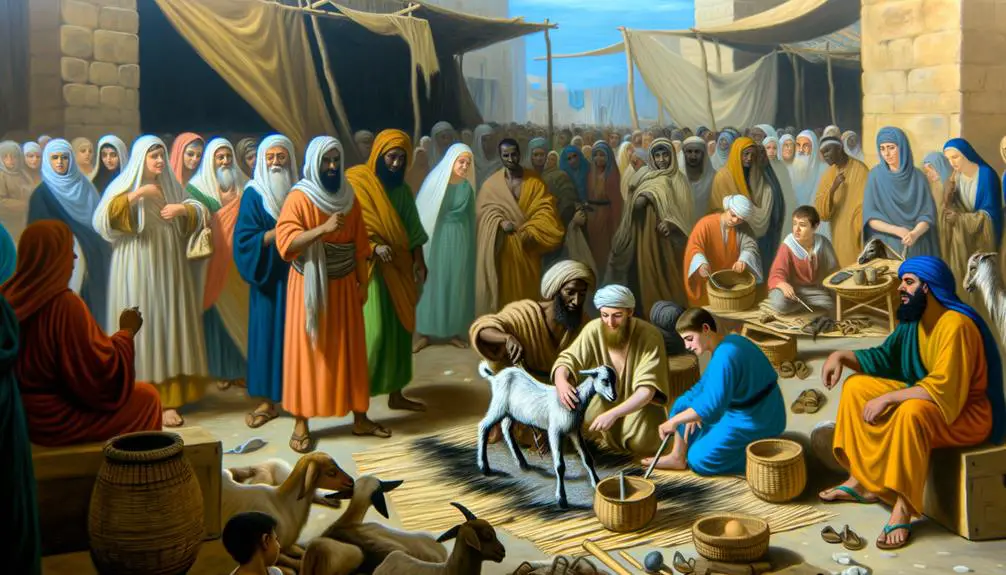
Understanding the pivotal role that tents played in the biblical era leads us to appreciate the societal impact of those who crafted them. Tent makers were central figures, supporting nomadic lifestyles that were prevalent among ancient communities, especially those described in the Bible. Their work didn't just provide shelter; it enabled entire societies to move, live, and thrive in harsh desert environments.
The economic roles of these artisans were multifaceted. They weren't merely manufacturers of temporary dwellings; they were essential contributors to the economy, fostering trade and interaction among various groups. By crafting tents, they facilitated the mobility that was necessary for trade routes to flourish, connecting distant communities and promoting cultural exchanges. This mobility was crucial for pastoral communities that relied on moving their flocks to new pastures, underscoring the interconnectedness of tent making with the broader economic system.
Moreover, tent makers' skills in working with materials like goat hair, leather, and linen were highly valued. Their expertise not only in the crafting but also in the repair of tents ensured that these essential items could withstand the rigors of nomadic life. This reliance on tent makers also fostered a sense of community and interdependence, as their work directly impacted the survival and comfort of the society.
In essence, the societal impact of tent makers in the biblical era was profound. They were integral to sustaining nomadic lifestyles and economic roles, embodying the spirit of resilience and adaptability that characterized ancient societies.
Spiritual Metaphors and Tents

In biblical narratives, tents serve not just as physical structures but also as potent spiritual metaphors, symbolizing transient earthly life and divine protection. These temporary dwellings reflect the nomadic lifestyle of many biblical figures, underscoring a life of movement and impermanence. The notion of tents as nomadic symbolism extends into the spiritual realm, illustrating the believers' journey through the temporal world towards a permanent home with God.
The use of tents as spiritual metaphors conveys the idea that life on earth is fleeting. Believers are portrayed as pilgrims, passing through this world without becoming entangled in its temporary pleasures and concerns. This perspective encourages a focus on spiritual values and eternal destinations, rather than the accumulation of earthly wealth and status.
Spiritual Concept |
Tent Metaphor |
|---|---|
Transience of Life |
Tents are temporary shelters, highlighting the fleeting nature of earthly existence. |
Divine Protection |
Just as tents provide shelter, God offers spiritual protection to His followers. |
Pilgrimage |
Tents symbolize the believer's journey through life, emphasizing movement towards a spiritual home. |
Community and Fellowship |
Tents facilitate communal living, reflecting the importance of fellowship among believers. |
Separation from Worldliness |
The simplicity of tents contrasts with permanent structures, symbolizing a life focused on spiritual, not material, wealth. |
Through these metaphors, tents become more than just fabric and poles; they embody deep spiritual truths about the human condition and the divine. They remind you that your time on earth is but a brief stop on the journey to eternity, urging you to live with purpose and in anticipation of a heavenly dwelling.
Frequently Asked Questions
How Did Ancient Tent Makers Source Their Materials, and What Were the Most Commonly Used Materials in Biblical Times?
When exploring how ancient craftsmen sourced their tent materials, you'll find they often relied on natural resources available to them. The most commonly used materials included animal skins, wool, and linen. These were chosen for their durability and material preservation qualities.
Dyeing techniques were also pivotal, utilizing natural dyes to enhance the aesthetic appeal of the tents. This process reflects a deep understanding of material properties and a commitment to craftsmanship in ancient times.
Were There Any Notable Differences in Tent-Making Techniques or Styles Between Different Cultures or Regions Mentioned in the Bible?
As you delve into the realm of ancient tent-making, it's clear that 'variety is the spice of life' applies. Different cultures and regions, influenced by their unique climates, developed distinct tent-making techniques and styles.
Climate influence wasn't just about survival; it shaped the very fabric of their shelters. Moreover, decorative practices varied widely, reflecting cultural identities.
Analyzing these differences offers a scholarly glimpse into the diverse world of ancient craftsmanship.
How Did the Economic Status of Tent Makers Compare to Other Trades or Professions in Biblical Societies?
When examining trade comparisons and social mobility in ancient societies, you'll find tent makers held a specific economic status. Not as lucrative as some trades, their work was essential, providing goods vital for nomadic and pastoral lifestyles.
Compared to professions like metalworking or pottery, tent making offered limited social mobility. However, their role was stable, ensuring a consistent demand. This stability, while not elevating their status significantly, offered a reliable livelihood.
Did Tent Making as a Profession Pass Down Through Family Generations, or Was It a Skill That Individuals Could Learn Outside of Familial Tradition?
Ever wondered how crafts were passed on in ancient times? Well, tent making wasn't just a family affair. It was a skill that individuals could also learn outside of familial tradition, often through apprenticeship opportunities.
This approach allowed for the sharing of techniques and innovations across communities, contributing to the evolution of the craft. The formation of guilds further facilitated this exchange, ensuring that tent making skills were preserved and advanced through generations.
Were Women Involved in the Craft of Tent Making, and if So, What Roles Did They Play in This Profession During Biblical Times?
You're delving into how gender roles and religious influences shaped involvement in historical professions. Specifically, you're curious about women's participation in tent making.
In this context, women likely played significant roles, reflecting broader societal and religious norms. Their contributions could range from actual crafting to support roles, depending on prevailing gender expectations and religious teachings of the time.
Analyzing these aspects offers insights into the nuanced dynamics of historical labor practices.
Conclusion
In conclusion, you've explored the multifaceted world of tent making in the Bible. From the Apostle Paul's dual role to the deep spiritual metaphors woven with tent threads, this ancient craft not only shaped societal structures but also stitched rich layers of meaning into biblical narratives.
Interestingly, if Paul were around today, he'd likely be a digital nomad, spreading messages from one online tent to another, showcasing the timeless nature of conveying sacred shelters and teachings across eras.

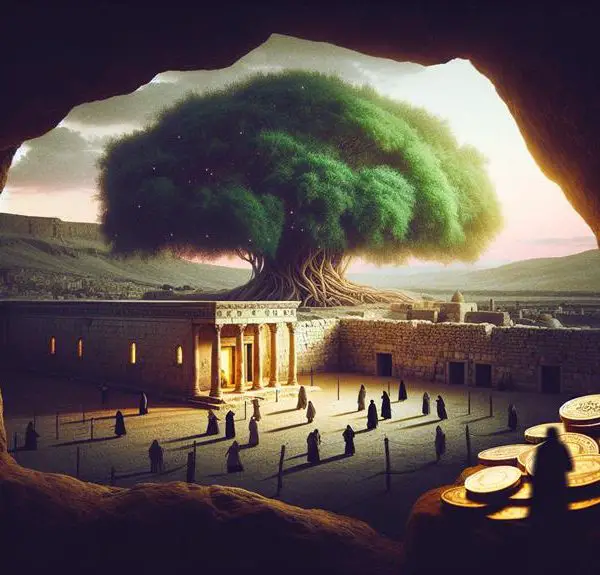

Sign up